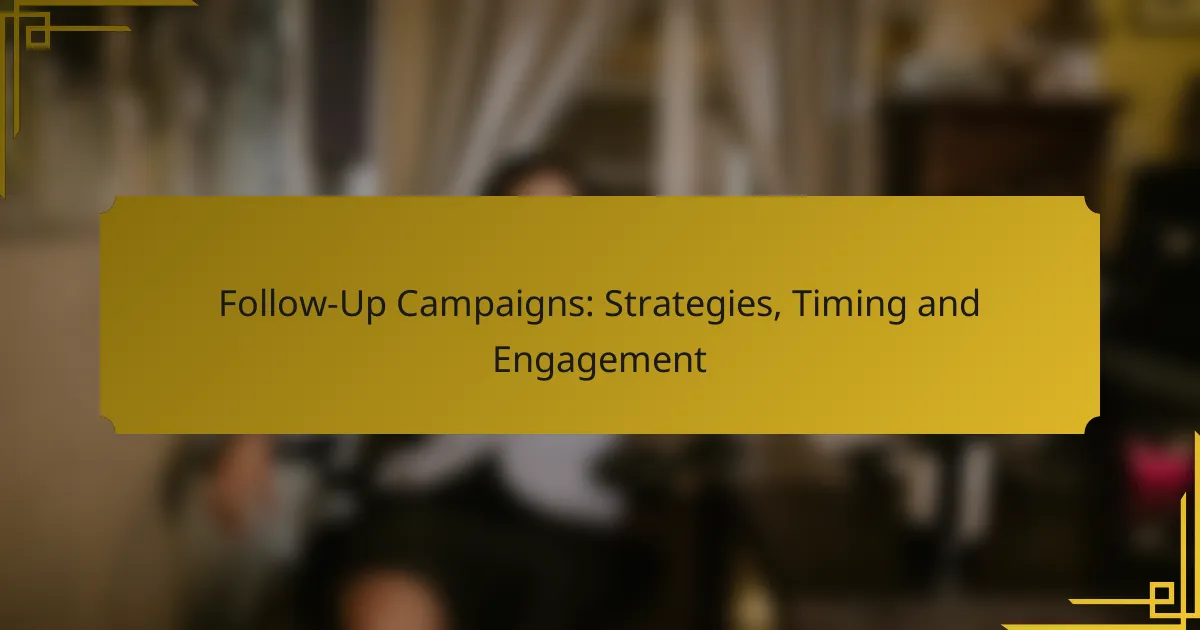Follow-up campaigns are essential for sustaining engagement with your audience after initial interactions, ultimately enhancing customer relationships and boosting conversion rates. Timing is crucial; effective follow-ups should be executed shortly after key events to maximize impact. By incorporating interactive elements and incentives, brands can foster active participation and strengthen connections with their audience.
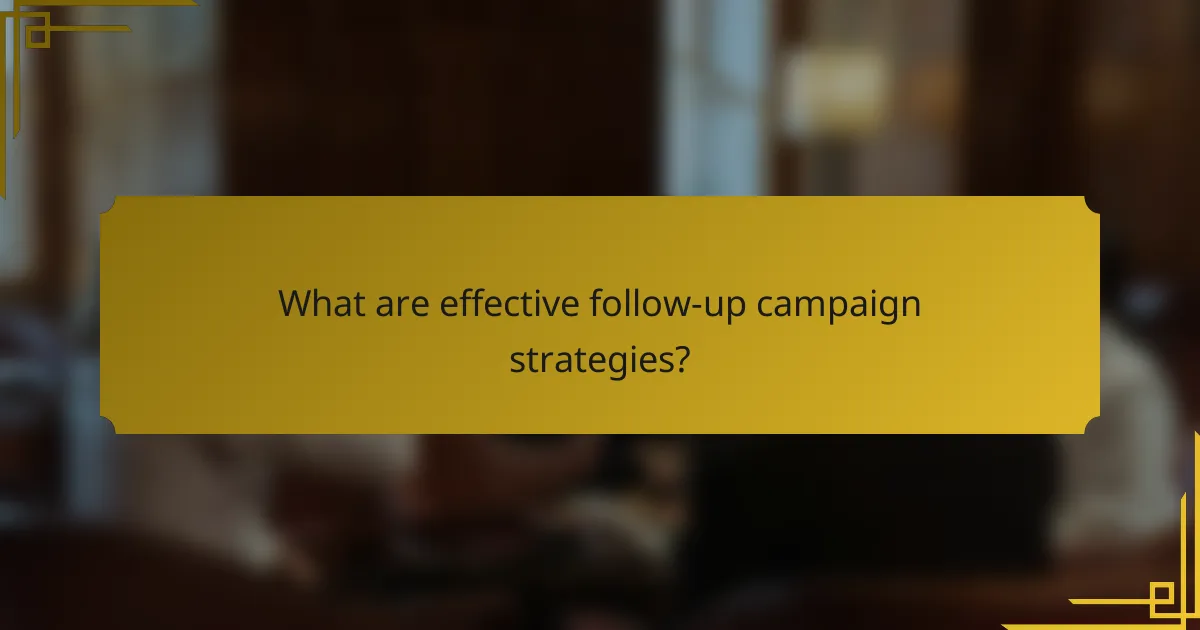
What are effective follow-up campaign strategies?
Effective follow-up campaign strategies focus on maintaining engagement with your audience after the initial contact. These strategies enhance customer relationships, improve conversion rates, and ensure that your messaging remains relevant and timely.
Email segmentation
Email segmentation involves dividing your audience into smaller groups based on specific criteria such as demographics, behavior, or purchase history. This allows for more targeted messaging that resonates with each segment’s unique interests and needs.
To implement effective segmentation, consider factors like age, location, and previous interactions. For example, a retail brand might segment customers based on their last purchase, sending tailored offers to those who bought seasonal items.
Personalized messaging
Personalized messaging refers to customizing your communications to reflect the individual preferences and behaviors of your audience. This can significantly increase engagement rates and foster a sense of connection.
Utilize data from previous interactions to personalize subject lines, content, and offers. For instance, addressing recipients by their first name and referencing their past purchases can make your messages feel more relevant and engaging.
Automated workflows
Automated workflows streamline the follow-up process by sending pre-scheduled messages based on user actions or time intervals. This ensures timely communication without requiring constant manual effort.
For example, you can set up a workflow that automatically sends a thank-you email after a purchase, followed by a feedback request a week later. This not only saves time but also keeps your brand top-of-mind for customers.
Multi-channel engagement
Multi-channel engagement involves reaching your audience through various platforms, such as email, social media, and SMS. This approach increases the chances of connecting with customers where they are most active.
Consider integrating your follow-up campaigns across channels. For instance, after sending an email, you might retarget the same audience on social media with related content or offers, reinforcing your message and increasing visibility.
Feedback loops
Feedback loops are essential for understanding the effectiveness of your follow-up strategies. By actively soliciting and analyzing customer feedback, you can refine your approach and improve future campaigns.
Encourage feedback through surveys or direct questions in your follow-up messages. Use this information to adjust your strategies, ensuring they align with customer expectations and preferences, ultimately enhancing engagement and satisfaction.
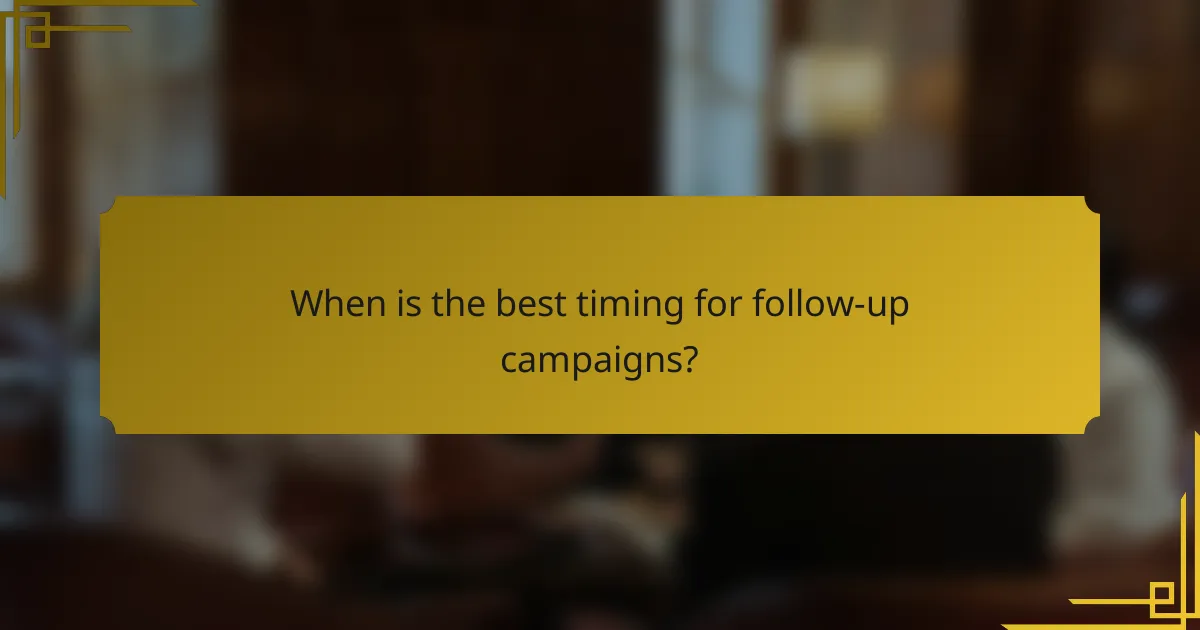
When is the best timing for follow-up campaigns?
The best timing for follow-up campaigns depends on the context of the interaction and the customer’s journey. Generally, follow-ups should occur shortly after a significant event, such as a purchase or inquiry, to maximize engagement and response rates.
Post-purchase follow-up
Post-purchase follow-ups are crucial for reinforcing customer satisfaction and encouraging repeat business. Ideally, reach out within a few days after the purchase to gather feedback or offer support. This timing allows customers to reflect on their experience while the purchase is still fresh in their minds.
Consider sending a thank-you email, a satisfaction survey, or recommendations for complementary products. These follow-ups can enhance customer loyalty and increase the likelihood of future purchases.
Event-triggered timing
Event-triggered timing refers to follow-ups based on specific customer actions, such as signing up for a newsletter or abandoning a shopping cart. These campaigns should be automated to ensure timely responses, typically occurring within hours or a day after the event.
For example, if a customer leaves items in their cart, sending a reminder email within 24 hours can effectively encourage them to complete the purchase. Tailoring the message to the specific action enhances relevance and engagement.
Seasonal considerations
Seasonal considerations play a significant role in the timing of follow-up campaigns. Aligning your follow-ups with holidays or seasonal promotions can increase their effectiveness. For instance, sending follow-ups during the holiday shopping season can capitalize on heightened consumer spending.
Plan your campaigns around key dates relevant to your audience, such as Black Friday or Valentine’s Day, and consider offering special promotions or discounts during these times to drive engagement.
Customer lifecycle stages
Understanding customer lifecycle stages is essential for effective follow-up timing. Different stages, such as awareness, consideration, and decision, require tailored approaches. For instance, follow-ups during the awareness stage should focus on providing information and building trust.
As customers move toward the decision stage, follow-ups should emphasize benefits and incentives to encourage conversion. Regularly assess where your customers are in their journey to ensure your follow-ups are timely and relevant.
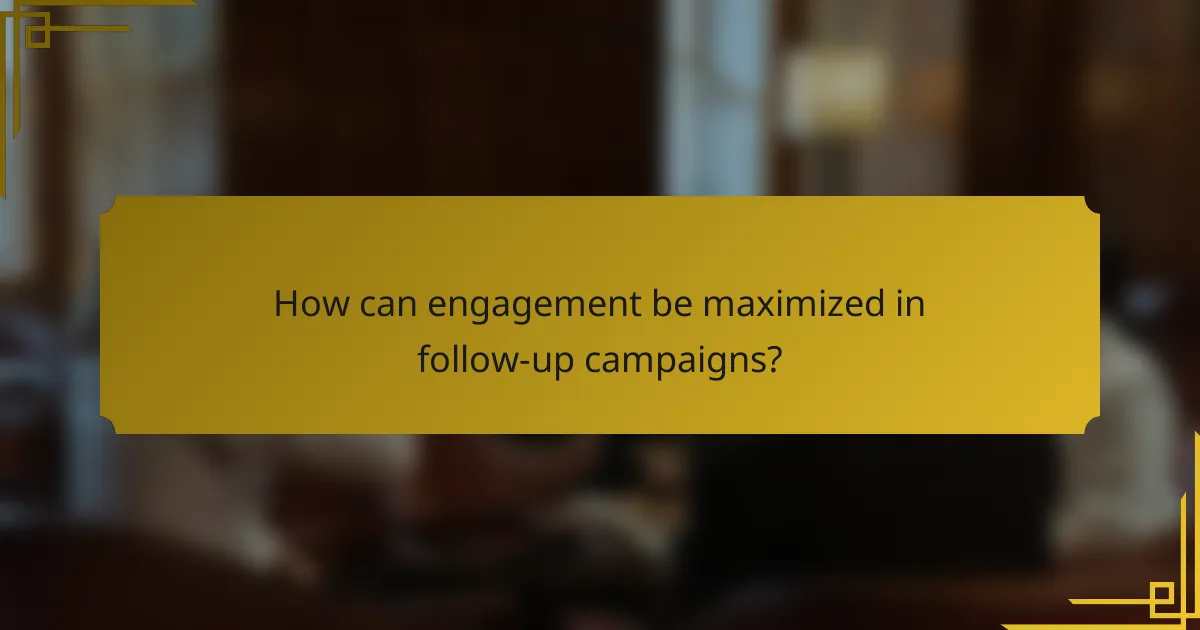
How can engagement be maximized in follow-up campaigns?
Engagement in follow-up campaigns can be maximized by incorporating interactive elements, offering incentives, and leveraging social proof. These strategies encourage recipients to participate actively, thereby increasing response rates and fostering a stronger connection with the brand.
Interactive content
Interactive content, such as quizzes, polls, and games, can significantly boost engagement in follow-up campaigns. By allowing recipients to actively participate, you create a more memorable experience that encourages them to interact with your brand further.
Consider using tools that enable easy creation of interactive elements. For example, a simple quiz related to your product can not only engage users but also provide valuable insights into their preferences.
Incentives and rewards
Offering incentives and rewards is a powerful way to enhance engagement in follow-up campaigns. Discounts, gift cards, or exclusive access to new products can motivate recipients to take action, such as completing a survey or making a purchase.
Make sure the incentives are appealing and relevant to your audience. A well-structured loyalty program can also encourage repeat interactions, fostering long-term engagement.
Surveys and polls
Surveys and polls are effective tools for gathering feedback while engaging your audience. They not only provide insights into customer preferences but also make recipients feel valued as their opinions are sought after.
Keep surveys concise and focused, ideally taking no more than a few minutes to complete. Offering a small reward for participation can further increase response rates.
Social proof integration
Integrating social proof into follow-up campaigns can significantly enhance credibility and engagement. This can include testimonials, user-generated content, or case studies that showcase positive experiences from other customers.
Highlighting real customer stories or reviews can help potential customers feel more confident in their decisions. Consider using visual elements, such as images or videos, to make these testimonials more impactful.
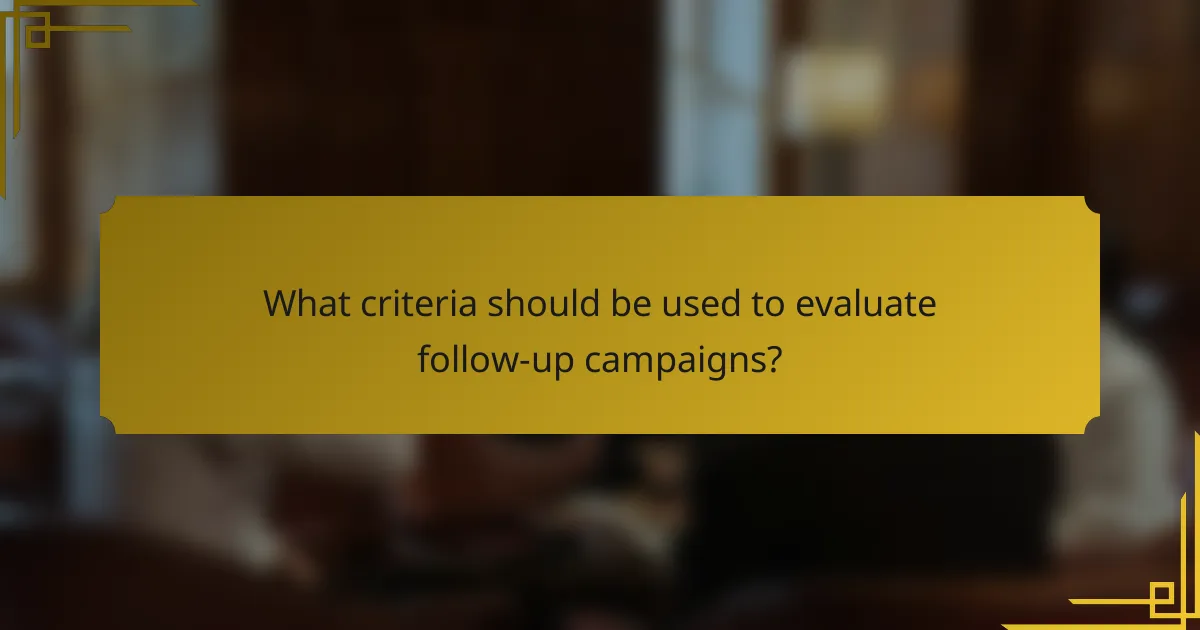
What criteria should be used to evaluate follow-up campaigns?
To effectively evaluate follow-up campaigns, focus on key performance indicators such as open and click-through rates, conversion metrics, and customer feedback analysis. These criteria provide insights into engagement levels, the effectiveness of the messaging, and overall customer satisfaction.
Open and click-through rates
Open rates indicate how many recipients opened your emails, while click-through rates measure the percentage of those who clicked on links within the email. A strong open rate typically ranges from 15% to 25%, whereas click-through rates can vary widely but often fall between 2% and 5% for most industries.
To improve these rates, consider A/B testing subject lines and optimizing send times based on your audience’s behavior. Avoid common pitfalls like using misleading subject lines, which can lead to higher unsubscribe rates.
Conversion metrics
Conversion metrics track how many recipients completed a desired action, such as making a purchase or signing up for a webinar. This metric is crucial for assessing the return on investment (ROI) of your follow-up campaigns. Aim for a conversion rate of around 1% to 3% for most email marketing efforts.
To enhance conversions, ensure your follow-up emails have clear calls to action and relevant offers. Monitor trends over time to identify what strategies yield the best results and adjust accordingly.
Customer feedback analysis
Customer feedback analysis involves gathering insights from recipients about their experience with your follow-up campaigns. This can be done through surveys, direct responses, or monitoring social media mentions. Pay attention to both quantitative ratings and qualitative comments to gain a comprehensive understanding.
Utilize feedback to refine your messaging and approach. Regularly solicit feedback after campaigns and be responsive to suggestions or concerns to foster stronger customer relationships and improve future campaigns.
